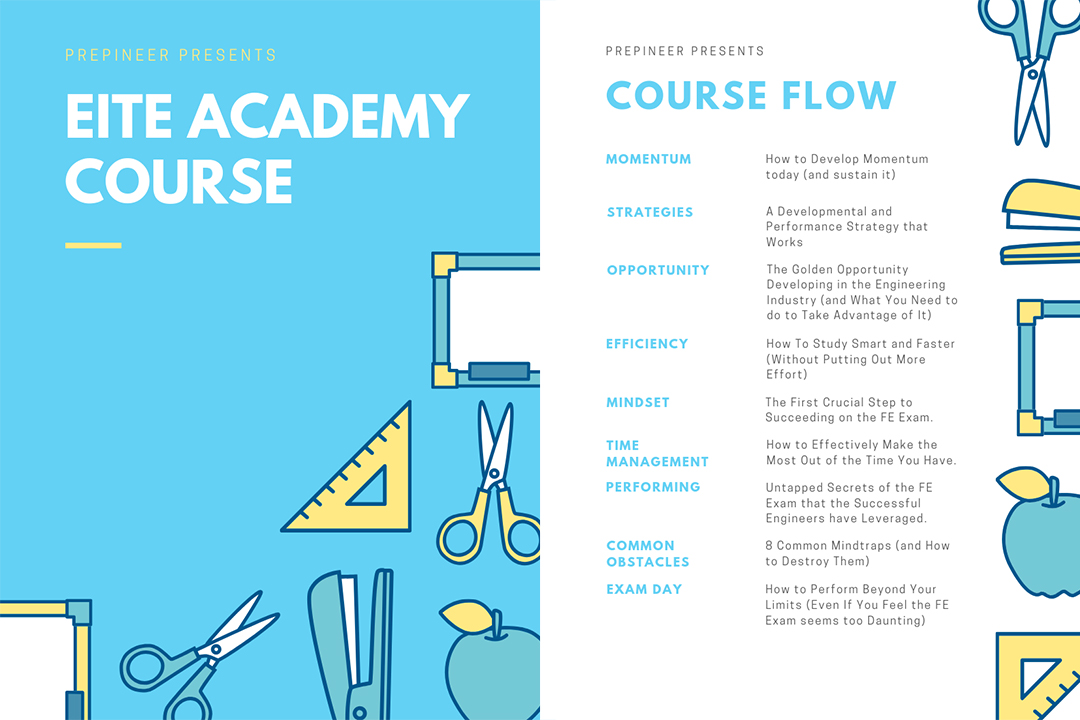The following is a breakdown of the 8 topics covered in the Mechanical PM portion of the Engineer in Training Exam.
The percentage next to the subject is approximately how much of the total content of the PM session that particular subject makes up. This breakdown is as outlined by NCEES on their website.
I. Mechanical Design and Analysis (15%)
A. Stress analysis (e.g., combined stresses, torsion, normal, shear)
B. Failure theories (e.g., static, dynamic, buckling)
C. Failure analysis (e.g., creep, fatigue, fracture, buckling)
D. Deformation and stiffness
E. Components (e.g., springs, pressure vessels, beams, piping, bearings, columns, power screws)
F. Power transmission (e.g., belts, chains, clutches, gears, shafts, brakes, axles)
G. Joining (e.g., threaded fasteners, rivets, welds, adhesives)
H. Manufacturability (e.g., fits, tolerances, process capability)
I. Quality and reliability
J. Mechanical systems (e.g., hydraulic, pneumatic, electro-hybrid)
II. Kinematics, Dynamics, and Vibrations (15%)
A. Kinematics of mechanisms
B. Dynamics of mechanisms
C. Rigid body dynamics
D. Natural frequency and resonance
E. Balancing of rotating and reciprocating equipment
F. Forced vibrations (e.g., isolation, force transmission, support motion)
III. Materials and Processing (10%)
A. Mechanical and thermal properties (e.g., stress/strain relationships, ductility, endurance, conductivity, thermal expansion)
B. Manufacturing processes (e.g., forming, machining, bending, casting, joining, heat treating)
C. Thermal processing (e.g., phase transformations, equilibria)
D. Materials selection (e.g., metals, composites, ceramics, plastics, bio-materials)
E. Surface conditions (e.g., corrosion, degradation, coatings, finishes)
F. Testing (e.g., tensile, compression, hardness)
IV. Measurements, Instrumentation, and Controls (10%)
A. Mathematical fundamentals (e.g., Laplace transforms, differential equations)
B. System descriptions (e.g., block diagrams, ladder logic, transfer functions)
C. Sensors and signal conditioning (e.g., strain, pressure, flow, force, velocity, displacement, temperature)
D. Data collection and processing (e.g., sampling theory, uncertainty, digital/analog, data transmission rates)
E. Dynamic responses (e.g., overshoot/time constant, poles and zeros, stability)
V. Thermodynamics and Energy Conversion Processes (15%)
A. Ideal and real gases
B. Reversibility/irreversibility
C. Thermodynamic equilibrium
D. Psychrometrics
E. Performance of components
F. Cycles and processes (e.g., Otto, Diesel, Brayton, Rankine)
G. Combustion and combustion products
H. Energy storage
I. Cogeneration and regeneration/reheat
VI. Fluid Mechanics and Fluid Machinery (15%)
A. Fluid statics
B. Incompressible flow
C. Fluid transport systems (e.g., pipes, ducts, series/parallel operations)
D. Fluid machines: incompressible (e.g., turbines, pumps, hydraulic motors)
E. Compressible flow
F. Fluid machines: compressible (e.g., turbines, compressors, fans)
G. Operating characteristics (e.g., fan laws, performance curves, efficiencies, work/power equations)
H. Lift/drag
I. Impulse/momentum
VII. Heat Transfer (10%)
A. Conduction
B. Convection
C. Radiation
D. Composite walls and insulation
E. Transient and periodic processes
F. Heat exchangers
G. Boiling and condensation heat transfer
VIII. Refrigeration and HVAC (10%)
A. Cycles
B. Heating and cooling loads (e.g., degree day data, sensible heat, latent heat)
C. Psychrometric charts
D. Coefficient of performance
E. Components (e.g., compressors, condensers, evaporators, expansion valve)
Source NCEES





